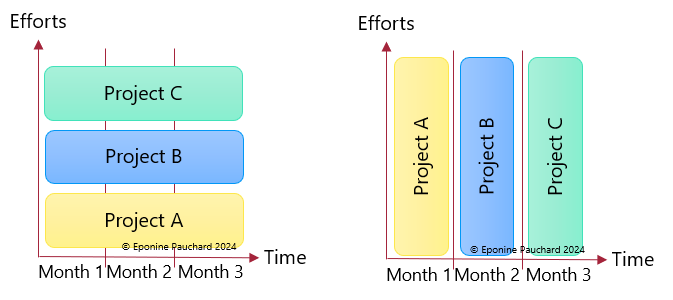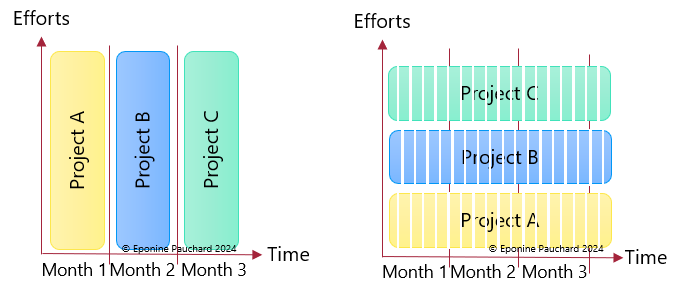Recently, a few people shared their frustration of not being to complete all their work. They had issue to prioritize and simply get things done. I experienced the same not so long ago. As every human, I am prone to work dilution. Glorified with the multitasking label, this way of working, unprecedented for machines, is a nightmare for our brains. Let me show you how the lack of focus cripples your efficiency.

What if I started renovating a house?
To make my point, I’ll use a very simple example. Let’s imagine that you’ve just inherited a house in need of a makeover, along with a good budget. Everything needs to be redone before you can enjoy it. So, you ask for two months’ vacation and get to work: renovating the kitchen and bathroom, sanding the floors and tearing out the wallpaper.
After two months, the electrician has changed the switchboard and sockets, you’ve painted two rooms and the fence. But it’s hard to see your progress. Indeed, the house looks like an endless construction site. You can’t see the end of the work around the house any more than at your job. Yet you work hard and never rest. You’re a model multitasker, switching from one activity to another as soon as there’s some wait time.
Let’s add some resources to get more work done!
Let’s test a variation of this story. You, your brother and sister have inherited the family home. Abandoned by your parents a few years ago, it needs a lot of work, but they’ve also left you a nest egg. With your spouses, a few friends and your teenagers, you decide to spend your summer fixing it up: 3 weeks and 15 motivated workers. Sounds like the title of a good video series.
To make sure everything goes smoothly, you discuss with your brother and sister the work plan and what you want to accomplish in three weeks. After lengthy discussions on the minimum to make the house viable, you end up with a list of 10 projects.
The work is progressing well, but after 3 weeks, it’s the same story: all 10 projects have been started, but nothing is really finished. The kitchen and bathroom are unusable, and the gutters are still dripping. Your team was motivated, competent, you had regular progress updates and your schedule was realistic.
How multitasking dilute our efforts?
Our brains can hardly do more than one thing at a time. So when we try to do several things at once, we’re actually doing them one after the other. We don’t have four processors in our brains. At least, not for complex tasks. So our efforts are diluted by multitasking.
Diluting efforts postpones delivery
It’s mathematical. With the same capacity, if I launch more projects at the same time, it will take me longer to finish them. Let’s take a simple example: three projects, each requiring one month’s effort. If I launch them at the same time, it will take me three months to finish all three projects. If I do them one after the other, then the first project will be delivered after one month, the second after two months and the third after three months.

There’s nothing you can do about it. Single-tasking delivers faster than multi-tasking. That’s the basis of agility: frequent delivery of finished products. With project 1 finished, I have value. In my house, I’ve got a room that’s been renovated, so I can cook, for example.
To be faster, you need to add resources. When you have tasks that can be done in parallel, it helps, but that’s not always the case. If you can have a painter in every room, you can’t pack 10 in a 5m2 room.
Diluting efforts reduces efficiency
Unfortunately, interrupting a task lengthens its duration. Whether it’s a micro-interruption (notification, quick question from a colleague) or a long interruption, our brain will have to work hard to get back to work.
We’ve all experienced it: when we’re going somewhere, our gaze stops on an object and we find ourselves doing something else, completely forgetting our first objective. These parallel quests are part of our daily lives. Interruptions can simply be elements in our environment.
The more projects you have in parallel, the more likely your are to be interrupted by a colleague. The graph therefore looks different, as the time required to concentrate increases the total workload.

Multitasking is clearly becoming less efficient than single-tasking.
How can you focus on a single project at a time?
Focus is a rare commodity in the 21st century. Our brains are fueled by instant gratification, which is much easier to obtain. I have an effective way for you to achieve it.
1. Set up a kanban Use a maximum number of projects or files that you handle in parallel. I recommend 3 projects in parallel, with a maximum of 5. The idea is to take advantage of the wait time of one project to move another forward.
2. Allocate time for your projects. Keep time for routine tasks, such as dealing with e-mails or unexpected requests. To stay in control of your time, you need to plan for the unexpected.
3. Turn off notifications (from your devices and colleagues) until you finish your task. Prepare to be efficient, depending on what works for you, put on some music, isolate yourself, set a stopwatch.
4. Visualize projects in progress and work accomplished. We forget to celebrate successes, no matter how small. Our applications reward us for trifles. Celebrate your progress!
On how many projects do you work at the moment?
